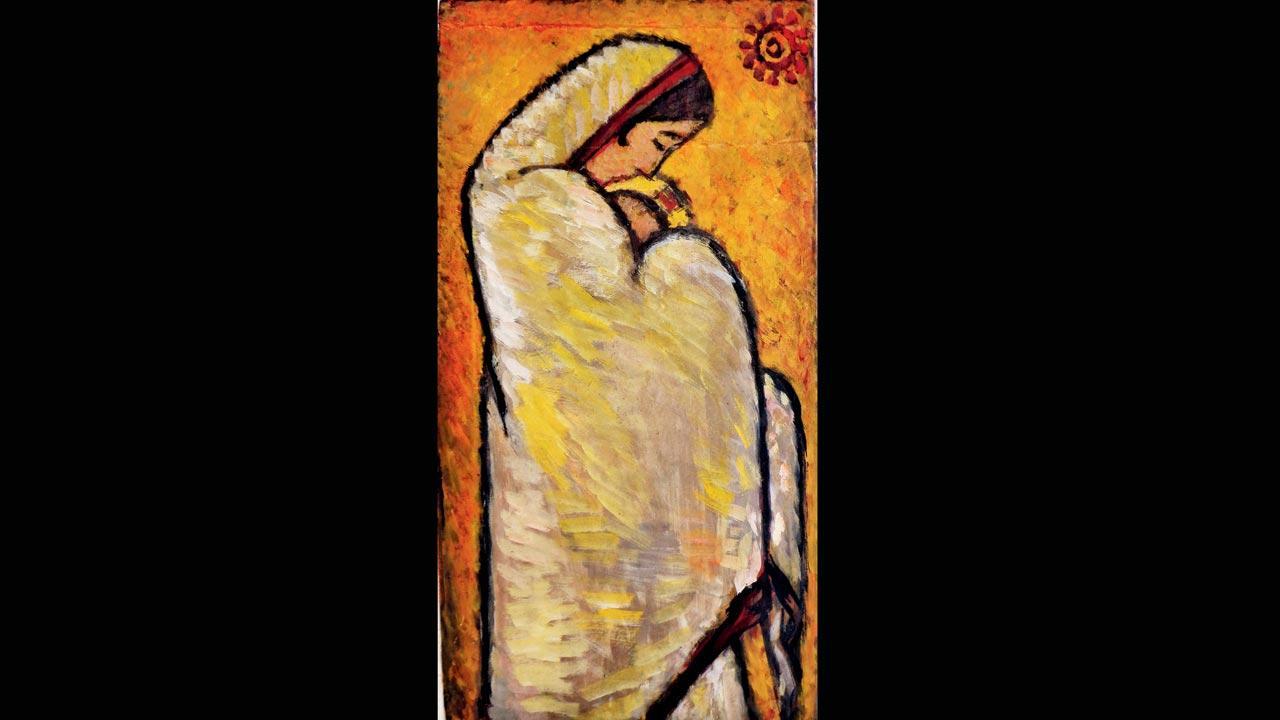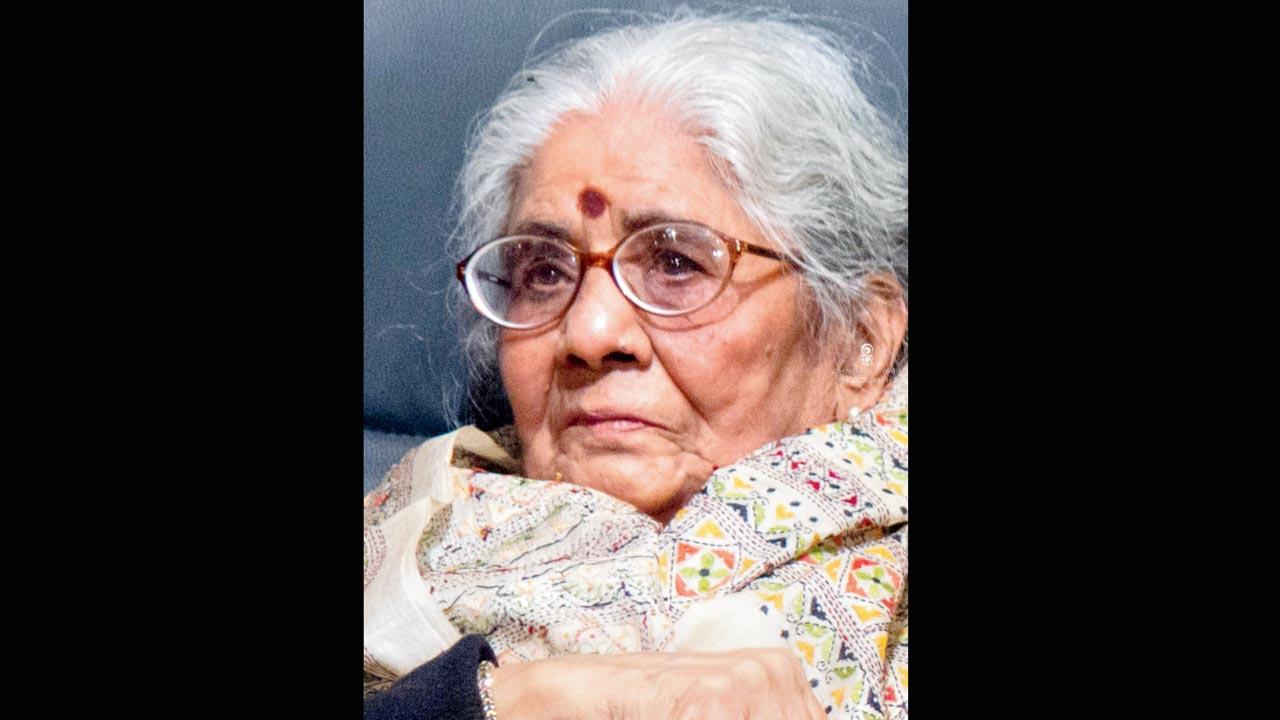A new anthology offers a nuanced understanding of the raw fibre of motherhood, and why happiness and suffering are integral to that experience

The Oldest Love Story is a collection of honest narratives by 24 women, who throw light on motherhood. Pic Courtesy/Mother and child, Jamini Roy
![]() There is a climactic moment in the life of the dying protagonist Nirmala, titular figure of Hindi writer Premchand’s novel, when she hands over her newborn girl to her sister-in-law. Nirmala requests the matron to feel free to either keep the girl unmarried, poison her or mete out any other treatment, except never to palm her off to an unfit groom. Nirmala’s wish for her daughter’s happiness was beautifully captured in Mannu Bhandari’s screenplay, which made way for the 1987 tele-serial Nirmala. Bhandari’s empathy for the suffering mother, who was once married off to a much older man, showed in the live-wire dialogues, which remain etched in my consciousness. I found a powerful expression of mother’s love in Bhandari’s Nirmala. At an earlier point in 1981, I had read Aapka Bunty, another Bhandari creation that tested the boundaries of a mother-son bond. But my young mind hadn’t registered the nuanced portrayal of the mother.
There is a climactic moment in the life of the dying protagonist Nirmala, titular figure of Hindi writer Premchand’s novel, when she hands over her newborn girl to her sister-in-law. Nirmala requests the matron to feel free to either keep the girl unmarried, poison her or mete out any other treatment, except never to palm her off to an unfit groom. Nirmala’s wish for her daughter’s happiness was beautifully captured in Mannu Bhandari’s screenplay, which made way for the 1987 tele-serial Nirmala. Bhandari’s empathy for the suffering mother, who was once married off to a much older man, showed in the live-wire dialogues, which remain etched in my consciousness. I found a powerful expression of mother’s love in Bhandari’s Nirmala. At an earlier point in 1981, I had read Aapka Bunty, another Bhandari creation that tested the boundaries of a mother-son bond. But my young mind hadn’t registered the nuanced portrayal of the mother.
ADVERTISEMENT
That’s precisely why I am grateful to author and film-critic Maithili Rao for making me privy to a new Motherhood anthology that includes Mannu Bhandari’s translated essay Girl on The Stairs, a tribute to her stoic, mute and docile mother whom the author loves to the core, but cannot place as a role model. Bhandari’s clear-eyed assessment of a traditional mother evokes respect. Not only is she angry about a woman who was devoted to her husband and mother-in-law to a fault, she also disapproves of her social reformer-father who was blind to the wife’s suffering. In one of her TV interviews, excerpted in the anthology, Bhandari says that real-life docile women impacted her writing. Since she found fewer women rocking the boat, she couldn’t possibly create braver versions in her stories. Her honesty is disarming.
 Mannu Bhandari’s essay reflects on a woman tied to her husband and mother-in-law
Mannu Bhandari’s essay reflects on a woman tied to her husband and mother-in-law
Rao and Rinki Roy Bhattacharya, writers, critics, friends and one-time Bandra neighbours, before the former relocated to Mysuru, have curated a collection of honest narratives of 24 women—and two men including filmmaker Saeed Mirza—who either recall their mothers or throw light on motherhood. The anthology draws upon a similar collection of women’s essays titled Janani, edited by Bhattacharya , which looked at the gamut of motherhood. The Oldest Love Story (Om Books International, Rs 395) spreads the net wider to include newer experiences, reaching out to varied voices like Dalit writer Urmila Pawar, feminist researcher CS Lakshmi, litterateur Shashi Deshpande and theatre director Chitra Palekar. I was a bit disappointed in the latter two narratives. The writers, known for their candour, seemed to hold back details at crucial junctures. I found them guarded in their outpouring.
The personalised essays provoke a deep inquiry into the mystique of motherhood. For instance, US-based author Sita Bhaskar focuses on a mother who bears with a teenage son whose actions “have driven another mother’s son to jump off a bridge to his death”. The fictional story, based on a real-life incident, captures a mother’s agony, as she faces the consequences of a crime committed by her son. Her duty is not over after packing him off to a foreign university. She has to “bring him back home, a juvenile, to be grown back into a man”. And she has to convince the world that she will do a good job this time.
 The book has been curated by Maithili Rao and Rinki Roy Bhattacharya, writers, critics, and one-time neighbours
The book has been curated by Maithili Rao and Rinki Roy Bhattacharya, writers, critics, and one-time neighbours
Similarly, Sandhya Sharma, an expert in early childhood education shares her arduous journey of raising a child with Down Syndrome. She speaks about her unpreparedness, especially during medical emergencies, and having to rely on the help of doctors, family members, and other parents, who make life livable for her. The story demonstrates every mother’s worry about her child’s developmental milestones; also that mothers’ relationships with children are inherently layered. They are never sorted or resolved for good.
Mothers pour immense energy into parenting their kids, and eventually feel exhausted and often unwanted. Bhattacharya calls it the “empty nest phase”, which she herself has braved and that’s why the book consciously encompasses mothers who “suffered” in a quiet way when their children took off and never returned. “I am afraid women invest too much, very foolishly, into mothering... Things are altering, but in India, it is still at a sluggish pace,” says the editor.
The Oldest Love Story houses extraordinarily gritty women who nurture their children despite odds—filmmaker Roopa Barua who parented two sons after losing her husband; visual artist Lalita Lajmi’s unique challenges while accepting her late daughter’s preference for an older life partner.
The book’s force lies in the collage of reminiscences of colourful quirky personalities who remain immortal in their children’s memories. Shaukat Azmi’s candid exchanges with her daughter are particularly hilarious. After watching Shabana Azmi in the commercial film Faasla, the matriarch declared: “Had Faasla been the first film of yours that I saw, I would’ve packed you off in marriage to the first available man, to protect the film industry from having to suffer you!” The Shaukat Azmi barometer never failed in its motherly duty of keeping the daughter self-aware.
Another self-assertive woman in the collection is filmmaker Saeed Mirza’s trend-setting Ammi who cast off the burqa in the 1930s. The industrious lady led a cutesy laboratory in her Mahim kitchen, which enabled Mirza’s father to manufacture fancy energy colas for the local market. Without much training or background, Ammi made concoctions for Golden syrup and 7Up —a mini-revolution she spearheaded in a yesteryear Anglo-Indian neighbourhood. The gutsy Muslim woman’s velvet bags also reflected the family’s financial strength, not to forget her native skills in electricity and plumbing departments.
Rao’s Kakki is a unique addition to The Oldest Love Story. It transports us to 1940s Mysore where a college girl (in the intermediate year) chooses to marry a widowed groom from Hyderabad, who was not just 16 years older, but a father of three. Kakki’s life revolves around her resolve to be the perfect mother to her stepchildren, even if that meant showering no demonstrative love on two of her own. Rao looks back with empathy at her mother who had “the courage of contradiction”—a Gandhian, who couldn’t let a non-Brahmin servant enter the kitchen, a believer in women’s rights who professed/practised the seclusion of a menstruating woman, and a parent who was more of an educator than a confidante to her children.
For me, The Oldest Love Story is precious because it celebrates mothers who negotiate cultural and physical distances and differences in their bid to save, nurture and protect their marriage. The Kannadiga Kakki adopted the lifestyle of a Telugu family in Andhra Pradesh. Bhandari’s maa left behind Ajmer memories only to be accepted in the prosperous moneylenders’ family in Bhanpura.
In the same vein, Fulbright scholar Asha Kuthari Chaudhuri essays the life of two Marwari women—her grandmother and mom—who followed their husbands to Assam. While the men did business, the dutiful wives co-opted themselves in joint family set-ups—perfecting the art of pickles, serving meals on time and raising children.
Needless to add, these mothers also had to negotiate the language divide in the new social environment they were pushed into. The author has evocatively captured the demanding social situations that women are subjected to. On the one hand, women tread cautiously in culturally unfamiliar milieus. Yet, they also imbibe native communication skills, as that is the need of the hour.
In this linguistic context, Kannada writer Vaidehi shares a poignant episode about her mother who wouldn’t let her Kannada—with a rich mix of Malayalam and Tulu—ride over the pure Kota Kannada spoken in the Brahmin household she was married into. As a newly married bride, her conversation style was made fun of. Amma joined the ridicule and slowly learnt to underplay the maternal impact. If people from her parents’ side visited, Amma would involuntarily shift to her dialect. But she never consciously or formally taught the lingo to her children. It is another story that daughter Vaidehi’s literary works later resonated the ‘mother tongue’ in full force. I think that speaks volumes about the politics of language in India, and the petty politics mothers put up with.
Sumedha Raikar-Mhatre is a culture columnist in search of the sub-text. You can reach her at sumedha.raikar@mid-day.com
 Subscribe today by clicking the link and stay updated with the latest news!" Click here!
Subscribe today by clicking the link and stay updated with the latest news!" Click here!







